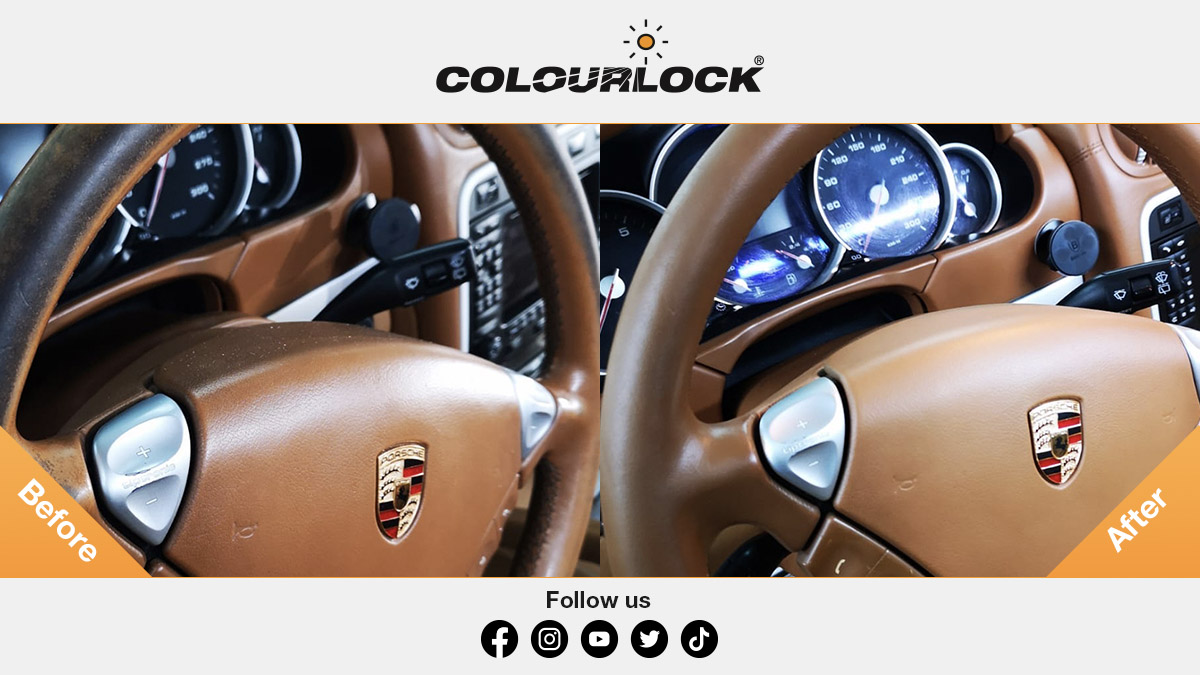Steering Wheel Detailing
Wednesday, March 9, 2022
(0 Comments)
Posted by: Alex Rudie
Written By: Jennifer Haines, English Customer Service, Colourlock 
A well cared for steering wheel is important for the entire interior image of a car. It is one of the first things you see and touch. A shabby looking steering wheel can even bring down the value of a car. Whether it’s a classic old-timer or simply a previously owned car getting ready for re-sale, bringing a leather steering wheel into condition is an essential part of auto detailing. Steering wheel leather is especially hard worn. Since leather is an open-pored material, anything that touches it is gradually absorbed. And it is constantly touched, with dirty hands or clean hands. Hands that have been eating hamburgers with ketchup and manicured fingers well cared for with lotion. The steering wheel takes it all in. Alcohol-based hygiene sprays, perspiration and skin oils have a particularly aggressive effect on leather. As a result, the leather becomes brittle, or the color softens and rubs off. Cleaning, repairing, and maintaining a steering wheel can bring beautiful results when the appropriate products are used in the correct order. Choose the right products for the project and the material. Leather and vinyl must breathe. If it is sealed completely with a different product such as a boat shellac for example, it will eventually dry out, crack and then mildew can enter the cracks. Look for products that offer breathability and no build-up. A sealant that builds-up needs to be removed with a solvent, which also removes the original surface. Products that do not build up over time are good for the leather and good for business. A product that wears off over time can be washed off and applied again, as a regular service, which is good for a detailing company. Another factor to consider when choosing leather products is a full range of products that work together. Products that are silicone-free, and made in a silicone-free environment, will not hinder coloring or painting in the future. A reliable company provides clear written instructions and service for questions about special cases, perforated leather, mixed materials such as wood, Alcantara (textile), rubber and plastic, damaged leather, changing the color, or going deeper into the plastic. When you start on the steering wheel, first tape off the areas that should not be treated such as buttons and the central logo. Next clean it with a mild leather cleaner. A soft brush with plastic bristles will help get into the grooves. It is easy to think that a strong cleaner is a better cleaner, but in fact, a cleaner that is too strong or not made for leather can do more harm than good. Leather should be treated as gently as possible. Only move onto a strong cleaner after trying with a mild cleaner, and only in case of unusually dirty leather. Be careful around the stitching, which may be in a contrasting color and is more fragile than leather. If there is no damage to be repaired and no color touch ups to be done, the sealant can be applied as soon as it is dry, right after cleaning. If repairs or color touch ups are needed, the surface needs to be prepared with a sanding pad and a degreaser. With a sanding pad, not sandpaper, smooth down any scratches or dents. It is important to use a sanding pad, and not sandpaper, on leather because the pad is softer and gentler. Do not exert pressure. Here patience rather than pressure is required. Wipe off the sanding dust with a soft cloth. Use a leather degreaser to remove any remaining oils so that the repair products or coloring will stick. Tip: Tape-test: if masking tape does not stick, it’s still too greasy and fillers or color will not stick either. If the tape sticks, it’s ready for repair and/or coloring. When it is dry, 24 hours after repairs and color refreshing, apply a breathable leather sealant. This is particularly important for light colored leather which discolors easily. For older leather, a sealant that nourishes and protects against UV rays is a good idea. Consider also if you want a matt finish, a semi-gloss glow, or a real shine. In addition to the practical factors, steering wheel work can be an enjoyable and interesting project. You can remove the wheel and work on it while sitting inside. It is small enough that you can get a nice feeling of completion relatively quickly. You can even delve deeper into the different styles and materials and how they developed over time. Steering wheel work is a great way to hone your skills, round out your knowledge, and increase your service offer as a detailer.
*This educational article was provided by Colourlock, an IDA Diamond Sponsor. It does not constitute an endorsement, guarantee, warranty, or recommendation by the IDA. The IDA makes no representation or warranties about any information contained herein.
|





































